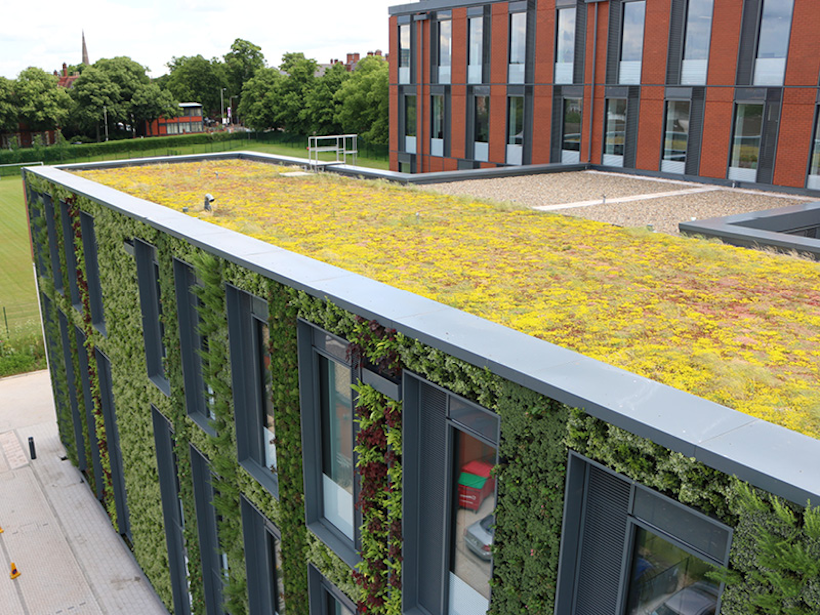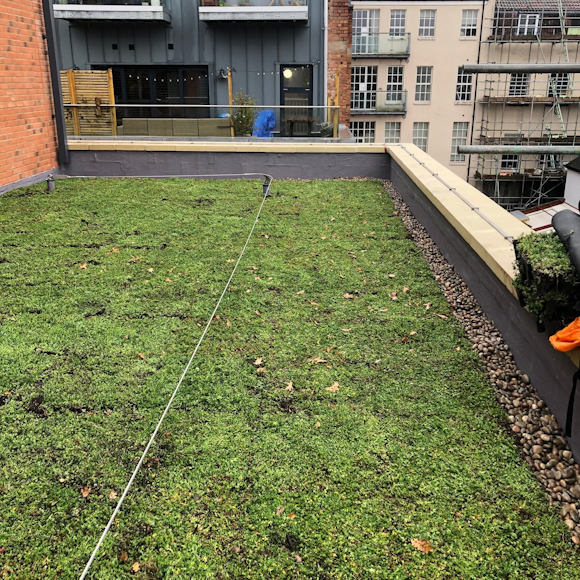There are numerous benefits of a green roof. Some are obvious and others less so. There are also some disadvantages to a green roof, although these are few and far between. To help you decide whether a green roof is right for your home or business, let’s look at green roof benefits, as well as the potential drawbacks.
8 green roof benefits:
1. Sound Insulation
Sound is a huge distraction, especially in a commercial building. Workers don’t want to listen to the rumble of heavy traffic outside their office and if you are at home, no doubt you won’t appreciate the roar of jets flying overhead late at night. A green roof is an extra layer of insulation and will absorb up to 30% of environmental noise pollution. You can get on with work, free from distractions, or sleep more soundly in your bed at night.
2. Aesthetics
There is no doubt about it: a green roof is visually appealing and, in the case of a public building, guaranteed to attract attention. The days of grey concrete and acres of glass and steel are long gone. People want aesthetically pleasing architecture and green roofs often play a big part in the overall design.
3. Temperature Regulation
Nature is extremely efficient at regulating temperatures. Flat roofs, unfortunately, are not. They absorb heat on a hot day and allow valuable heat to escape on a cold day. The addition of green roof modules helps to regulate temperature in a building. Your home or commercial building will feel warmer in winter and cooler in summer. This will save you money on heating and air-conditioning costs. Isn’t that a good thing?
4. Air Quality
Urban areas are often notable for their lack of vegetation, which leads to a build-up of carbon dioxide and other harmful pollutants. A green roof makes the most of the unused space. Plants absorb pollutants and emit oxygen, improving air quality and helping the environment.
5. Rainwater Retention
Rainwater runoff is a big problem if your area is prone to heavy downpours and flash floods. A green roof can absorb a significant amount of rainwater, helping to prevent localised flooding.
6. Buildings Rating
If you are hoping to build a sustainable home or improve the building’s rating with BREEAM, a green roof is an excellent starting point. It’s even better if you choose plants native to your local geographic area and you are sure to find favour with the local planning department.
7. Biodiversity
City centres and urban environments are often inhospitable to birds, insects, and other creatures. A green roof helps to promote biodiversity by attracting wildlife. Extra features such as bird baths and beehives can be added to boost the roof’s ecological impact.
8. Protect Your Roof
A green roof installation will protect your roof from UV rays and acidic rain, thus prolonging its natural life.
Disadvantages of a Green Roof
There are very few disadvantages, but the cost of installation is the main one. A green roof will be more expensive to install than a traditional flat roof, as the underlying structure may have to be strengthened to cope with the extra load.
Green roofs offer so many benefits that you would be crazy not to consider an installation in an appropriate area. Once installed, a green roof is beautiful, low maintenance, and eco-friendly.
We all want to give the next generation the best atmosphere to study in, and careful building design is important to make sure of this. Including a living wall offers far more than a nice looking feature, it can also protect a building facade from UV and pollution. They can go a step further though, improved air quality can help students focus their minds and the sound absorption properties can give a quieter more focused area.




